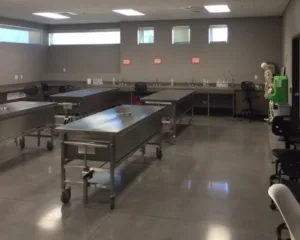I’ve noticed something interesting about educational institutions over the years. Usually, once they have researched, procured, and installed a showcase display environment, that’s the last you will hear about it. That’s explains why I often pursue a long-term reporting strategy. Simply stated, I like to follow up. I am curious to see what has happened, to see if a project has evolved or quietly vanished into educational anonymity.


Take the 3D visualization initiative at Nevada State College, for example. After I penned my first piece, Nevada State College Flies High, I wrote a follow-up piece, Unparalleled Learning. That explains why I returned this year to the outskirts of Las Vegas to visit Nevada State for a third time.
This last year, Nevada State College has experienced a building and enrollment boom. But with their venerable 3D instructional infrastructure in place, and new construction becoming the new major emphasis, did 3D visualization and display technology take a back seat? Apparently not. And the reasons are worth careful examination.
3D visualization (stereo, using passive display technology) continues to be integrated into every anatomy and physiology offering on campus at Nevada State. Systematized, if you will. And college leaders and faculty have not held pat (stayed where they are – Man. Ed.). They have also integrated 3D visualization into their new student orientation activities. Dr. Andy Kuniyuki, Ph.D., Dean of the School of Liberal Arts and Sciences explains exactly how they do it: “Every new student orientation is conducted in rooms where they show, side-by-side, 2d (PowerPoint) and stereo 3D visualization.” Dean Kuniyuki chuckles as he reminisces, asking the question: “which do you prefer?” He knows the answer beforehand, but he is trying to excite students for the first time, exposing them to this valuable learning tool even before students attend their first classes. “They are thrilled that we have that possibility [3D visualization].”
But the big news doesn’t revolve around the use of 3D visualization in new student orientation activities. Rather, Nevada State is moving forward on its visualization agenda in two ways. First, 3D visualization is making a big move into the School of Nursing. Use of 3D visualization in anatomy and physiology classes initially caused the word to get out and spread. There was interest from the students themselves and college administrators were hearing that older students wanted these richly visual learning experiences, as well. Nursing school leaders knew that there was huge evidence that pathophysiology is a defining course for nursing students.
The current emphasis for instruction is a nursing/whole person perspective. Yet, a firm grasp of pathophysiology is known to be a real predictor of how students will perform as nurses in the field. What the school was missing was a teaching perspective that zoomed down to the tissue, cellular, and molecular levels. 3D visualization could help with this specific instructional challenge by filling a missing link in their instruction. A plan was developed to have instructors from both the liberal arts/sciences and the school of nursing co-teach these nursing courses in the NSC visualization labs. The first co-taught offerings begin this coming spring.
The second phase of expansion of 3D visualization at Nevada State College involves their advanced pre-med experiences, specifically, their human dissection cadaver lab. Nevada State is ramping up plans to provide both live and recorded stereo 3D cadaver dissections, using a head-mounted GoPro camera and stereo-displaying Panasonic projectors in the dissection lab and other classrooms. Hoping to deliver instruction as close to reality as possible, Dean Kuniyuki submits: “We want to have students prepared well. “He continues: “In the past, when we were only able to have two cadavers, it was the MDs that performed the dissections. [With 3D] we want more students to do hands on, rather than just passively watching what the MDs are doing.”
Currently, Nevada State has grown to six chambers, hosting three human cadavers and one synthetic cadaver. The synthetic cadaver is constructed of materials that feel like real human flesh (a real cadaver is stiff) and maintains natural coloration (real cadavers lose coloration). The synthetic cadaver looks and feels like a live human body, including a fat layer that oozes. Fluids can also be pumped into it. The synthetic cadaver, however, is still a consumable resource. Fortunately, the synthetic cadaver qualifies for free replacement after it has been used repeatedly. Not so with the human cadavers. The cost of cadavers runs the show.
For that reason, the use of 3D video recording and display translates well, economically speaking. Students will make fewer mistakes on costly cadavers, becoming familiar with the tasks at hand (through visualization) before they work with the cadaver. “We want students, besides observing, to get their hands dirty, so to speak,” explains Kuniyuki. He also expects students to view 3D videos 3-4 times before making the hands on switch. (In our observations of other 3D visualization projects worldwide, this is something we have called “learning replay”—the willingness of students to watch and re-watch 3D visualization for learning advantage.) Then, “when they are then working with the human cadavers, they know exactly what to expect,” he says.
Since many educators can be fiercely tradition-minded, it begs the question: “how did this growth in 3D visualization come to be?” Well, there is a mix of reasons. One reason is that the college had an existing infrastructure in place. “Because we had invested in the original 3D visualization infrastructure, we knew we had the possibility of expanding it in this manner,” beamed Dean Kuniyuki. In addition, school administrators are clearly listening to students, valuing the overall effectiveness of visualization, and seeking to provide improved learning experiences at a more affordable cost.
Currently, one of their challenges is exploring a transition from passive to active 3D in other areas of the campus. The jury is still out on this upgrade. I’ll have to return to see how the active-passive scuffle turns out. (LS)

